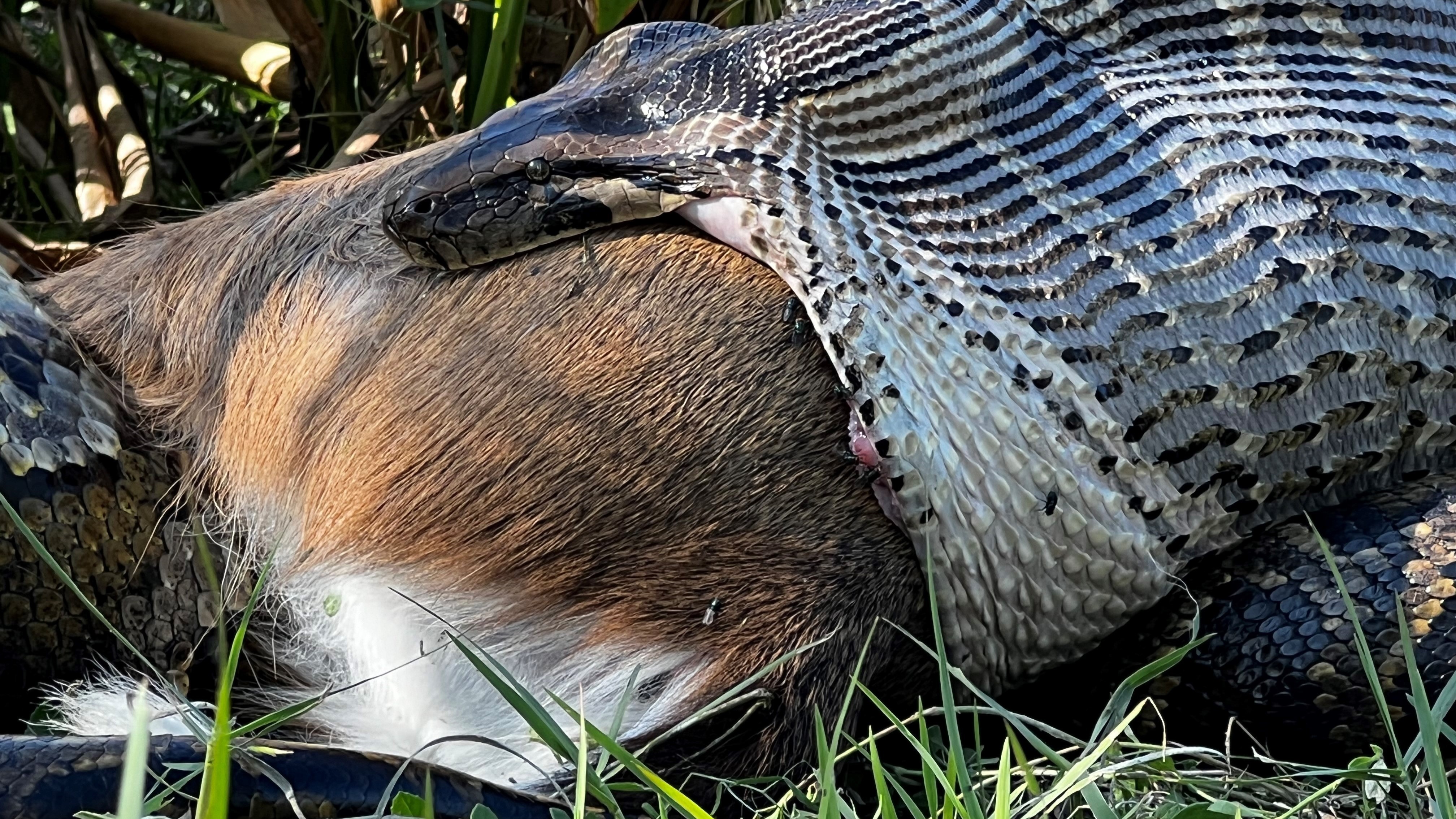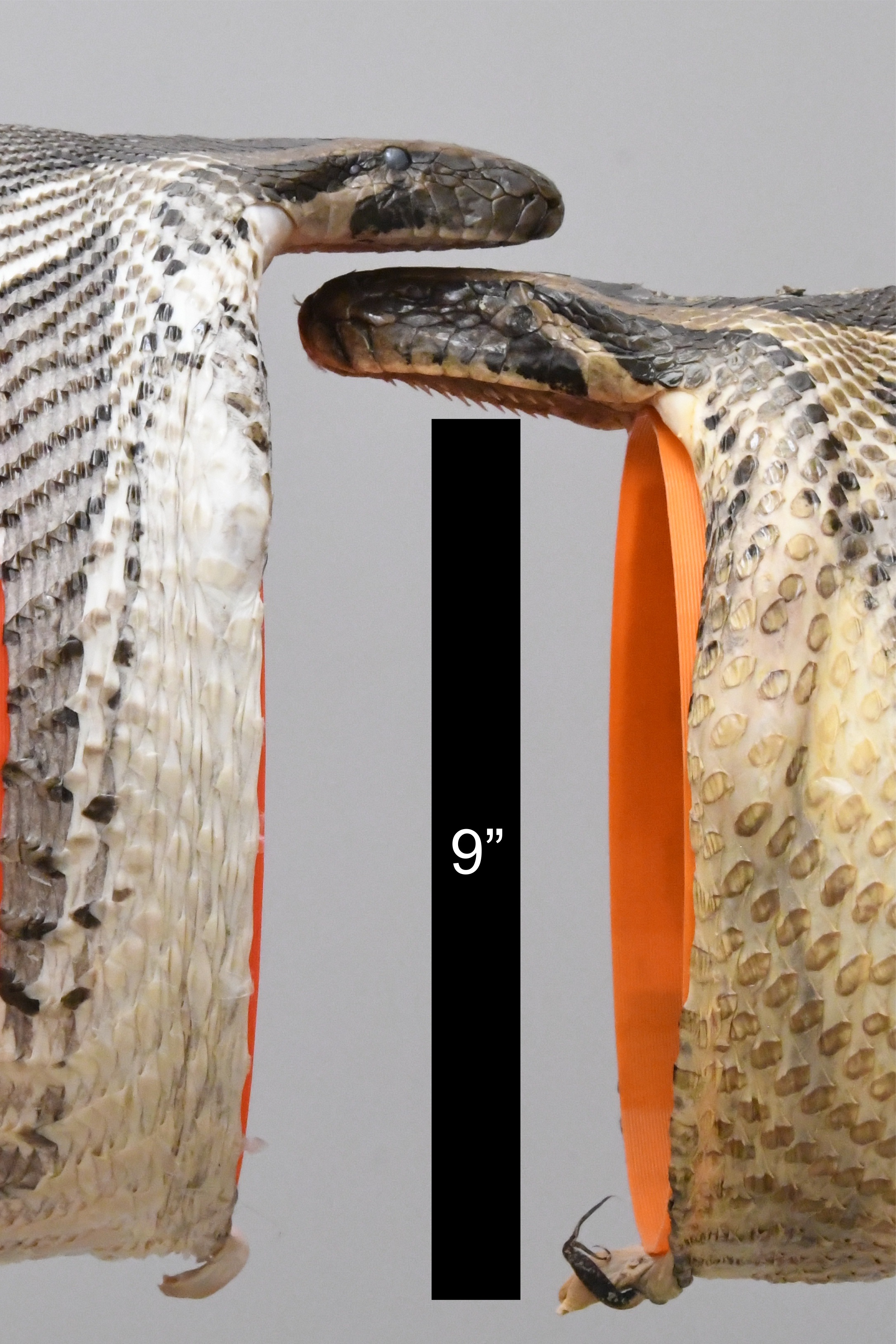'Truly primal': Watch Burmese python swallow deer whole in Florida Everglades by stretching its mouth to the absolute limit
An invasive Burmese python in the Everglades was spotted eating a white-tailed deer around 67% of its mass by stretching its mouth to almost the maximum width of what is physically possible.

A huge Burmese python has been found swallowing a deer whole in Florida's Everglades. The impressive feat challenges what gape models suggest the invasive snakes are physically capable of.
"It felt like we were literally catching the serial killer in the act and it was intense to observe [in] real time," Ian Bartoszek, a wildlife biologist and science coordinator at the conservation organization Conservancy of Southwest Florida, told Live Science in an email.
The female Burmese python (Python bivittatus) measured 14.8 feet (4.5 meters) long and weighed 115 pounds (52 kilograms). It was discovered feasting on a white-tailed deer (Odocoileus virginianus) that weighed 76.9 pounds (35 kg) — almost 67% of the snake's mass. To devour the deer, the snake's mouth stretched so wide it reached 93% of its maximum gape, according to a study published Aug. 22 in the journal Reptiles & Amphibians.
"This was the most intense and impressive sight we have observed in 12 years of tracking pythons in southwestern Florida," Bartoszek, one of the study authors, said. "It was truly primal and felt like a scene that had been playing out for millions of years wherever you have large snakes. Unfortunately our native wildlife in Florida have not evolved with this apex predator and you are seeing that result with these images."
Related: The biggest snake in the world (and 10 other giant serpents)
Burmese pythons are an invasive species in the Everglades and were introduced at some point in the mid to late 20th century. The first sighting was in 1979, and by the 1990s they had gained a stronghold, feasting on native species while having no natural predators to control their population. While the current population size is unknown, experts estimate there could be hundreds of thousands in Florida. Over the last few decades, Burmese pythons have decimated local ecosystems, wiping out several mammal species.

Burmese pythons are known to eat deer and even alligators, but finding the predators in the act is challenging, limiting how much scientists know about what these apex predators are capable of eating, and therefore how much of an impact they're having on the ecosystem.
Sign up for the Live Science daily newsletter now
Get the world’s most fascinating discoveries delivered straight to your inbox.
Related: Which animal has the stretchiest mouth?
According to the study, the previously assumed maximum gape for a Burmese python (the width it can open its jaws) was around 8.6 inches (22 centimeters). However, the researchers examined three of these snakes — including the 14.8 foot python — and found they had a maximum gape of 10.2 inches (26 cm). The discovery has "significantly affected" models showing what Burmese pythons are physically capable of swallowing, the researchers wrote.
"These observations and this study serves as another warning sign to the threat imposed on the Everglades ecosystem by the Burmese python," Bartoszek said.

Burmese pythons can swallow huge prey because their jaws aren't fused at the front, which enables them to stretch far wider than similar-sized snake species. "Our anatomical measurements indicate this deer was very near the size limit on the prey that could be consumed by this snake," study author Bruce Jayne, professor of biological sciences at the University of Cincinnati, said in a statement emailed to Live Science. "Hence, these snakes resemble overachievers by sometimes testing the limits of what their anatomy allows rather than being slackers that eat only 'snack size' prey."
The deer-eating snake was located with the help of a male python called Ronin. Ronin is fitted with a tracking device that leads researchers to females — part of a program that releases males as "scout snakes" during the breeding season. Burmese pythons are prolific breeders, with each female able to produce dozens of eggs each season. Removing females is a way of controlling the population.
"Each breeding season [Ronin] leads us to multiple females that we humanely remove before they have a chance to lay eggs," Bartoszek said. "All of the pythons we remove are humanely euthanized. We have a lot of respect for the Burmese python and they are here through no fault of their own. However we understand the impact they are having on native wildlife and are not sitting on the sidelines."

Hannah Osborne is the planet Earth and animals editor at Live Science. Prior to Live Science, she worked for several years at Newsweek as the science editor. Before this she was science editor at International Business Times U.K. Hannah holds a master's in journalism from Goldsmith's, University of London.









